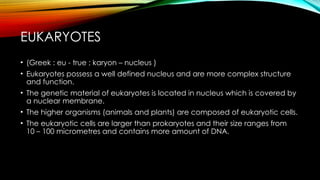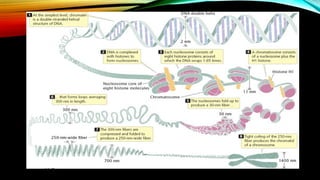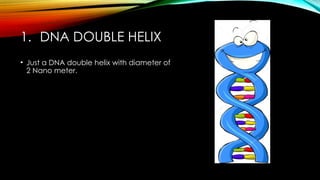genome organisation in prokaryotes and eukaryotes.pptx
- 1. GENOME ORGANISATION IN PROKARYOTES AND EUKARYOTES
- 2. WHAT IS A GENOME ? • The total DNA (genetic information) contained in an organism is regarded as the genome. • Thus, the genome is the store house of biological information. It includes the chromosomes in the nucleus and the DNA in mitochondria and chloroplasts. • The study of the structure and function of genome is called genomics.
- 3. WHAT ARE PROKARYOTES • (Greek : pro – before ;karyon – nucleus) • Prokaryotes are the primitive cells. They lack a well defined nucleus and relatively possess simple structure. • Generally we know the best example for the prokaryote which are bacteria. • Generally bacteria are very small size ranging from 0.5 to 5 micro metres and we see later how the DNA is packed in a prokaryote.
- 4. GENOME ORGANISATION IN PROKARYOTES. • In prokaryotic cells we know they lack a true nucleus. • But where will be the genetic material of bacteria? • Nucleoid - the area of a prokaryotic cell in which the chromosomal DNA is located. • Generally if we take an example of E.coli ( width - 0.5 micrometres length -2 micrometres) contains genetic material which of 1.5 millimetres in length which contains 5.44X106 base pairs. • How that much length of genetic material fitted in very small cell. • We discuss now how it is Possible
- 5. E.coli cell lysed and we can observe the total genome of E.coli outside the cell.
- 6. GENOME PACKAGING IN PROKARYOTES (SUPER COILING) • The prokaryotes compress their DNA into smaller spaces by supercoiling. • Genomes can be negatively supercoiled (the DNA is twisted in the opposite direction of the double helix) or positively supercoiled (the DNA is twisted in the same direction of the double helix). • Most of the bacterial genomes are negatively supercoiled during normal growth. • E.coli is negatively supercoiled. • The DNA of E.coli contains 50 -100 domains or loops and electron micrographs show that some of them are independent of coiling.
- 7. PROTEINS INVOLVED IN SUPER COILING • Multiple proteins act together to fold and condense prokaryotic DNA. • In particular one protein called HU. Most abundant DNA binding protein in nucleoid and is positively charged. • HU bind to DNA and introduce sharp bends in the chromosome ,generating the tension necessary for the coiling. • IHF (integration host factor) bind to specific sequences within genome to create further bends. • The DNA is wound around a tetramer of HU proteins like in eukaryotes(DNA wrapping around histone octamer). • DNA topo isomerase 1 and DNA gyrase help maintain the supercoils. • H-NS (histone like proteins) and factor for inversion stimulation(FIS) are some maintenance proteins involved in regulation of gene expression.
- 9. EUKARYOTES • (Greek : eu - true ; karyon – nucleus ) • Eukaryotes possess a well defined nucleus and are more complex structure and function. • The genetic material of eukaryotes is located in nucleus which is covered by a nuclear membrane. • The higher organisms (animals and plants) are composed of eukaryotic cells. • The eukaryotic cells are larger than prokaryotes and their size ranges from 10 – 100 micrometres and contains more amount of DNA.
- 10. GENOME ORGANISATION IN EUKARYOTES • We know that DNA of a eukaryotic cell is suspended in the nucleoplasm of the nucleus. • The total amount of a DNA present in a eukaryotic cell is nearly 6.4 billion base pairs which when extracted from a cell equals to 6 feet of DNA. • How 6 feet of DNA is condensed in a cell which is just few micro metres ? • We will now discuss how the DNA is packed in an eukaryotic cell.
- 12. DNA PACKAGING • The DNA packaging in eukaryotes is done in 7 stages a. DNA double helix b. Nucleosome c. Solenoid d. Super solenoid e. Rosettes f. Coils g. Chromosome.
- 13. 1. DNA DOUBLE HELIX • Just a DNA double helix with diameter of 2 Nano meter.
- 14. 2. NUCLEOSOME • The negatively charged DNA wraps around an octamer of histones. • There are 5 types of histones • Core histones – H2A,H2B,H3 and H4 . They form the octamer with 2 sets of each protein. • Linker histone - H1 . This links the DNA from one octamer to another octamer. • The whole structure is called nucleosome. • Diameter – 11nm
- 15. 3. SOLENOID • Solenoid or chromatin fibre. • Group of nucleosomes. • The structure is similar to beads on a string. • Diameter – 30nm.
- 16. 4. SUPER SOLENOID • Or also called loops. • Chromatin fibres form loops which attach to non histone proteins. • Diameter – 300nm
- 17. 5. ROSETTES • The non histone proteins from the super solenoid forms the scaffold protein. • The loops of DNA attach around the scaffold protein. • Diameter – 700nm.
- 18. 6. COILS • Rosettes gets stacked on each other to form coils. • Diameter – 700nm.
- 19. 7. CHROMOSOME • Coils become more compact and finally forms the chromosomes which we observe during the metaphase of cell division. • Diameter – 1400nm.
- 20. THANK YOU



















